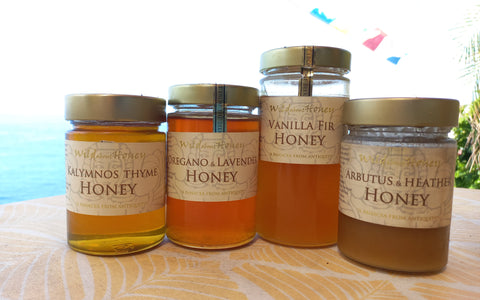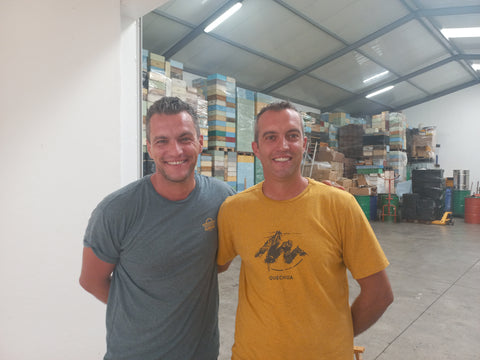Thank you to the amazing Sara Wyndham Lewis, the Honey Sommelier, the UK's top honey taster for this heartfelt endorsement in this May edition of Beecraft magazine. @honeysommelierlondon


Something about the quality of existence these last few years has resulted in life being unpredictable to the extent that it has been chaotic and unplannable. If ever there was a time to quote Burns, it would be now....to put it simply life has been rough. We seem to perpetually find ourselves on a wing and prayer. So once again a last minute decision saw the family drive up from Portugal to participate in the BBC Good Foods show after a hiatus of 11 years, where we had initially launched Wild about Honey. The Ghosts of Brexit may never be put to bed, and for small food companies like us, it's the gift that just keeps giving. Still at some point you have to get back in the saddle and just put yourself out there.

2000 miles later and with the good fortune to have dear friends Steve and Jenny, living nearby to the NEC, who provided warmth, food, practical assistance and shelter, we set out to put on a show and see first hand how the honey was received by the public at large and hopefully find new customers and introduce them to the world beyond supermarket honey. It was also an opportunity to taste and experience the entire range ourselves, something we rarely get a chance to do. We also thought we would try out some cross promotion with other small producers at the show, and have some fun, particularly with cheese pairings.

It was truly wonderful to sample over and over again, the diversity of this range, which, with all due humility :) , is I believe, the best curated range of honeys available in this country. The depth of flavour and diversity of the Portuguese honeys, the elegance and subtlety of the new Greek honeys together present amazing possibilities for food pairings and should be of real interest to chefs as well as anyone else with a curious palate who enjoys good food. There really is something in this range for every palate.

We sourced three cheeses from the Cheshire cheese company, a creamy cheddar, a smoked cheddar and one with jerk seasoning, with chillies and garlic. From the Cornish Cheese company, their superb Brie and strong Blue. Its fun pairing food, sometimes flavours are antagonistic, strong opposites which balance each other, other times subtle complementaries which gentle preserve the balance of flavours. The most interesting part is the synergy, where two flavours come together and create something new. So if you get a chance, experiment.

Here is what we came up with - Creamy Cheddar and Wild Lavender honey, Smoked Cheddar and Chestnut honey ( amazing), I did not know if any honey could stand up to a Jerk seasoned chilly cheese, but the Kalymnos thyme honey was equal to it with its strong herbal notes. The Cornish Brie with its delicacy was served by the exquisite Vanilla Fir honey and the Powerful Cornish Blue balanced out by the butterscotch chewy sweetness of Eucalyptus honey.

A Few Ideas
We also paired up a wonderful picnic ham, a dry cured ham from The Greek Farmer, with our wonderful resinous Pine honey.
An Artisan made Cretan olive oil and lemon salad dressing with the complex and slightly fruity Laurissilva Cloud forest Honey.
If you are cooking meats like Lamb, Beef or Duck, especially if you are roasting them, finish them with a generous glaze of the incredibly rich and chocolatey Serra Da Estrela honey, Chestnut honey or Pine honey, they all work incredibly well. Just put them on right at the end, so you actually preserve all the goodness of the honey while enjoying its spectacular depth of flavour. There are an awful lot of things you can do with honey besides using it as the powerful medicine that it is

On the subject of Medicine.
Two days into the show, after hours of talking we felt our throats go, headache and mild fever started to develop and we knew that we had to get through at least two more days, so we opened a jar of Arbutus honey and Serra da Estrela honey and between the two of us consumed half a jar of each through the night. That was all it took. The symptoms vanished. Which brings us neatly to a question we often get asked, What is the right dosage, how much honey should I use. The best way to use it is to let your body do the talking, just keep consuming it till you don't want to anymore. Your body will tell you when its had enough. When you are taking honey for general well being a spoon or two in the morning and last thing at night is fine, however if you are getting ill its generally not enough.

So, thanks to all of you who showed up there and participated with us, we hope that you continue to enjoy this incredible range of lovingly produced and curated honeys for years to come. Till the next time. xRaT

As you may have noticed in January of this year we ( after a few hurdles) launched a range of Premium Raw Greek honeys curated from around Greece. We entered all 6 in the Great Taste Awards. (We did not enter any of our spectacular Portuguese Range because to be honest they have already won so many awards and have a loyal following we thought we'd give them a rest this year ).


Out of 6 honeys entered, four of them won stars, including the Elegant and bold Kalymnos Thyme honey, a one way sensory teleportation machine to the Aegean Islands. The Oregano and Lavender, Vanilla Fir and Arbutus and Heather all won a star each. Congratulations to the Beekeepers, especially Isabella.
I have to say with all due respect to the judges at Great Taste, I think they must have had palate exhaustion or taken leave of their senses temporarily, because the Red Fir and Pine honey won nothing! . The Red Fir honey is one of the most elegant, rich, sensuous beautiful honeys we have ever sold. The mouthfeel alone is a sensation to experience. Still I forgive them this time, we all make mistakes :) and everyone deserves a second chance, even the illustrious judges at great taste.
I recently returned from my summer buying trip to Portugal and have, in over a decade, never seen it so bad. As a consequence we have a very limited amount of Eucalyptus, Algarvian Thyme and Algarvian Heather honey. We are still waiting on the Chestnut honey from the north which is being taken this month, fingers crossed.
The Bad News- Honey we should always remember is a product of nature and the progressive loss of habitat, severe drought conditions continuing for many years, Forest fires , EMF stressors like 4 and particularly 5G towers, in addition to the ongoing stresses of Varroa mites and now Asian Hornet invasions in Northern Portugal has created something like a perfect storm for bees and honey production this year with many beekeepers just throwing in the towel.

There is always a little good news too and this year it came in meeting some new beekeepers, particularly the fabulous Nunes brothers, both in their early 40's, strong, super-capable and knowledgeable and all round serious pro's. I am very grateful to have met and spent time with them, chewing over the state of the world and of course tasting (and buying) their superb honey.
Whatever you're notions about the reasons for the weather, and your personal philosophical predilections about diet, you need honeybees, we all do. If not for them and the people who care for them and love them, we would all starve.
We urge you, if you have a garden or land or are farming to make habitat for bees and wild pollinators. Leave water out for them too. If you come across an exhausted bee, feed her. These wonderful little beings who do so much for us literally work themselves to death. We are so conjoined with them and our relationship is so profound, that every single thing they produce from Honey to Wax to Propolis is of unique benefit to humans. They actually share their food with us, I don't know of any other creature that does that. Blessings to all. XR